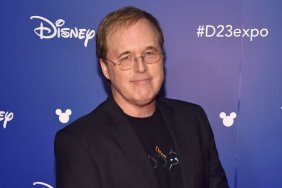
Fans of Japanese anime are used to seeing names like Otomo or Miyazaki or Masamune or Kon in the credits of their favorite movies, but Michael Arias, director of the new animated feature Tekkonkinkreet moved from L.A. to Japan sixteen years ago, spending that time working behind the scenes on some of Japan’s top animated films before producing a segment of the Wachowski’s The Animatrix.
Tekkonkinkreet, his first animated feature as a director, is based on Taiyo Matsumoto’s popular serialized story “Black and White” which was reprinted here in Viz’s “Pulp Magazine.” Set in the crime-filled Treasure Town, it’s the story of two orphans, the worldly Black and his dim-witted naïve younger brother White, who must survive in a city that’s being taken over by Yakuza gangsters and alien assassins. Arias has turned the comic book into a vibrant and stylish film that stands up to the work of the more well-seasoned Japanese anime masters.
Superhero Hype! had a chance to talk to Arias about the origins of the project and his thoughts on how animation is perceived in the United States.
Superhero Hype!: The manga comic book came out in the early ’90s and I understand you’ve spent about that long trying to get it made into a movie.
Arias: Yeah, well it was serialized starting I believe in ’93 and I was introduced to it in ’95 like right after it was gathered together as a book, actually three volumes. I guess pretty soon after first reading it, I was somehow involved in trying to get it made into a movie, first as a computer graphics feature animation with a guy named Koji Morimoto and myself supervising the animation, and then eventually in the form it is now as director, though it wasn’t my initial intention to direct it.
SHH!: Computer animation these days is fairly pervasive, but it wasn’t as evolved back then, so was the technology at a point where you could have done a computer animated version?
Arias: Koji Morimoto, he’s sort of my mentor in traditional animation, I think he just wanted to see what we could do with computer animation, and I was still very involved in computer animation and software development for computer graphics. Our pilot film we did in ’99, and a couple things happened: we finished our pilot and then the backing for the film fell apart, and then I got asked to produce “The Animatrix” and so, I spent about three years after that just focused on “The Animatrix.” The other thing was that Morimoto himself sort of lost interest in the project and got pulled away by other stuff. While we were making “Animatrix,” I was still working with a friend to write a screenplay for “Tekkon” and was still very much focused on getting it made eventually. My co-producer on “Animatrix” when we finished that, we were sort of casting about for the next project and she suggested that I direct “Tekkon” and she produce it.
SHH!: Were you already involved in animation when you first went to Japan or did you get more involved as you spent time there?
Arias: Yeah, I was doing special effects. This is in the days before computer graphics was so central to the film industry as it is these days. I went to Japan first in ’92, and I had already been working in the United States doing special effects and a branch of visual effects called “motion control photography.” There is a certain amount of overlap with traditional animation, but yeah, going to Japan, I had an interesting-sounding job offer. I had studied some Japanese in college and thought it would be a nice chance to put it to use. I didn’t expect to be there 16 years later and I certainly didn’t expect to make animation such a big part of my life.
SHH!: It’s fascinating to have a movie like this that’s so traditionally Japanese with essentially a Westerner at its helm. Did you have a team there that you’d been working with a long time that you brought onto the movie?
Arias: Yeah, yeah. It’s a lot of the same crew who helped me make “Animatrix” and the studio that we work at, which is called Studio 4° C…

SHH!: Yeah, they did “Mind Game” which I loved.
Arias: Oh, great. Well there’s a lot of crossover with “Mind Game.” The director of “Mind Game,” Masaaki Yuasa, his kind of high school rival is the animation supervisor for “Tekkon” and he was actually brought on at our studio because Yuasa wanted him to work on “Mind Game” and they share a very similar character style, and of course, it is a small studio, so there’s a lot of the same animation and computer graphics staff working on both movies, although “Mind Game” was completed well in advance of our movie. I think 4° is at the vanguard of traditional animation. It’s a quite interesting place to work.
SHH!: I read the manga when it was serialized here in “Pulp,” but it actually was published in black and white. Was that the case in Japan, too? I was surprised that the colors in the film were so vibrant, something I wasn’t used to.
Arias: Yeah, that’s a very strong part of the esthetic of the comic book. There’s like two or three color pages at the beginning of each volume, but that’s the extent of it.
SHH!: How did you develop things from the original comic? Did you use them as storyboards as storyboards for any part of the movie?
Arias: No, no, no, although there are certain shots that are definitely inspired or copies of layouts in the comic book, but no. Of course it was our bible in a lot of ways, but we did our own storyboards, and one of the reasons that color came to play such an important part in it. Well there’s a couple good reasons. One was that I just thought I wanted to make this very immersive experience and I really wanted to do something that you could only do in cinema, and I really wanted if anything to get away from the comic book art origins of it. You’ve got so many things that you can play with: sound, motion, color, that you don’t have access to when you’re creating comic books, and I just thought to really make it a project that you could say was worth doing in film, you really wanted to make as much use as possible the tools that are available only to the filmmaker. Another reason for our very audacious or extravagant use of color is that my art director, Shinji Kimura had just finished art directing a movie called “Steamboy” for Katsuhiro Otomo, who directed “Akira” way back when. I don’t know if you’ve seen it but “Steamboy” takes place in industrial era Manchester, and the whole movie is drawn basically in shades of grey, and Kimura had just come off of that show. He was working on “Steamboy” for most of ten years, and so, I think he really wanted to just have a freehand with his palette and “Tekkon” was a really good… you know, there were very few constraints. We did have a somewhat peculiar color scheme in mind for “Tekkon” largely based on advertising of 1950’s and 1960’s Japan. There’s a very strong thread running through a lot of that advertising, I’m not sure if it’s due to the printing materials or the inks they were using, but there’s a very peculiar flavor to the graphic design of the ’50s and ’60s in Japan, and we thought that would be a nice way of evoking this era that’s gone by or just lives on only in this one little town.
SHH!: Is Treasure Town meant to be a future version of Tokyo? It seems to have some aspects of the present-day city.
Arias: If anything, I didn’t want it to seem like a recreation of a real city. I wanted it to feel like some kind of parallel universe, like it’s got futuristic elements, some sort of references to Tokyo and Osaka, but also other big Asian cities, Hong Kong certainly and Jakarta. I wanted it to certainly seem like an organic place, but something where no one’s been to quite that place.
SHH!: I understand you’ve invented technology that combines traditional animation with computer graphics. Was that used for this movie? It seems like the environments are very three-dimensional, despite looking hand-drawn.
Arias: We spent a lot of time working out ways of using computer graphics to add an extra dimension of either camera movement or depth to scenes, and certainly used a lot of computer graphics to get some of the more complex scenes that take place in the city where you have hundreds of cars and buses and cable cars and trains and all these different things moving around. I wanted it to feel like a documentary set in a hand-painted world, although we tried not to have the computer graphics FX call attention to themselves as such, but the computer graphics were definitely something that we relied on, and in part, the software that I’d written for previous projects.

SHH!: I’m hoping to see the movie on a big screen because I think that stuff might translate better.
Arias: Yeah, if you’ve got a chance, I’d love for you to see it not only on a big screen, but in film, it really is a different experience.
SHH!: I wanted to ask you about the decision to use the Japanese name rather than the “Black and White” title more Americans might be familiar with. When I first heard about the movie, I didn’t even realize it was based on the Manga that I had read. Why didn’t you use that title?
Arias: Well, you must be very well tied in, ’cause it’s not that well known. (laughs) Yeah, yeah, I’ve been told that it was one of Pulp’s less popular titles. I wanted to go back to the original title, because “Tekkonkinkreet” that word doesn’t really mean anything in Japanese either. It’s kind of a scrambling of the words for “reinforced concrete” but it’s just a funny word that little kids might say. I just thought that “Black and White” was a little too straight ’cause it’s not just Black and White, and if anything, the story is not just black and white or yin and yang. It’s got a lot more complexity to it, and I thought the sound of the words “Tekkonkinkreet” evoked this idea of a toy box that a kid spilled out on the ground, and that was one of the images I had in mind for this whole world, as being this ramshackle, perhaps a bit chaotic, environment.
SHH!: Did you feel the need to tone down the violence in the comic book at all for the movie?
Arias: I think we had to lose a couple minor episodes along the way. In that sense, there may be a bit less, maybe one fight scene less or perhaps even more than that, but I wasn’t making a deliberate effort to mellow it out. I just thought there’s a certain element of repetition that is necessary when you have a serialized manga like that, which in a movie, just gets to be a little bit repetitive. So yeah, we did do quite a bit of brain surgery on the structure and the content of the manga, though I think in the end, people can look at the movie and I don’t think the changes we made really call too much attention to themselves as being from a different story or anything. It’s a pretty organic adaptation I think.
SHH!: I hadn’t read the comic in about ten years, but I did remember a lot of scenes from it while watching the movie.
Arias: Well, that’s nice.
SHH!: Was there any attempt to dub the movie into English?
Arias: Yeah, actually I’m mixing the English dub today. I don’t know if the English will end up in theatres. It will certainly be on the DVD. I kind of think watching animation with subtitles is a bit ridiculous, particularly with Japanese animation, because there’s no original language, and to make people try and absorb all that visual information at the same time as they’re reading, in the case of “Tekkon”, a ton of dialogue—I mean the characters really never shut up—so I really wanted to do a proper dub. I’m actually quite happy with it. We have actual kids doing Black and White and so yeah, it’s quite nice, and I think it works really well dubbed. There seems to be a group of purists among the lovers of Japanese animation who somehow think the original Japanese performance is more authentic than something that’s done with care after the fact in another language. Unless it’s a samurai movie or something that’s really married to the Japanese culture… other than that, I think it’s a bit of silly, although I have to say, I did like “Steamboy” with the English dub because it actually was like, “Hey, everyone’s speaking with an English accent.”
SHH!: I’m glad you mentioned “Steamboy” because that was one of the few examples where I thought the English dub worked much better and brought more to the movie than the subtitled version.
Arias: I mean, not only did they have a great cast and they were all speaking the Queen’s English, but the story takes place in Manchester, and all of a sudden, it just had a bit more verisimilitude I think.

SHH!: I completely agree. Where do you lie in the whole 2D vs. 3D animation debate? Right now, in Hollywood, they’ve almost completely edged out 2D and hand-drawn animation…
Arias: God knows why. Well, I know why, but Japan is really the only place you can make a movie like “Tekkon” or “Mind Game” not simply because of the very high level of traditional animation skill, but also because I think American audiences aren’t quite ready… it’s very early days in animation in the United States in a strange way. Of course, originally, the Japanese animation industry evolved as sort of a cheap copy of Disney animation, but at this point, the range of stories and genres and styles that the average Japanese person sees by the time they’re an adult is just so far beyond what even fans of animation in the United States ever get exposed to. It’s just people have so much more of a sophisticated vocabulary. I think Americans are really just getting their feet wet now and discovering a lot of stuff, so in that sense, it’s a very interesting time, and I’m really looking forward to seeing what kind of films actually take off here. I would say studios and distributors are not necessarily known for their forward thinking in that sense and once they’re locked into a pattern that pays off, they’re not likely to go too far afield of that. I think it’s going to take some really blatant moneymakers to really get more of these kind of movies out there, and I also think that just because this is something that’s really a homegrown cottage industry in Japan, that it may be quite a long time before there’s movies like this that get really mainstream exposure. I don’t know. I’m very interested to see how it all works out. I felt from the beginning with “Tekkon” that this movie had a very European sensibility and that for example, the French or the British would appreciate the levels of symbolism and ambiguity and metaphysical quality of the story. I’ve been very pleasantly surprised to see the movie with American audience so far and find people who the movie connects with. I’m just not really sure what’s in store.
SHH!: I think a lot of the 2D movie animation we see these days is based on TV cartoons, using the same style, which people don’t necessarily need to see on the big screen.
Arias: No, no, it doesn’t necessarily play that well on the big screen.
SHH!: Of course, having said that, “The Simpsons Movie” comes out here in a month, and that will probably change everything in the sense that it will make more money than many of this year’s computer animated movies.
Arias: Yeah, I’m not sure. American animators, there are some extremely talented animators out there, but they don’t have the experience of working on films like this, so any traditional animation that’s made in the United States by necessity is going to have a very different look and feel. Part of Japanese animation is not just the content but the technique they’re using, it’s evolved along a very different path from American or Western traditional animation.
To see how it’s evolved, you can check out Tekkonkinkreet when it opens in select cities on Friday, July 13.
Source: Edward Douglas









